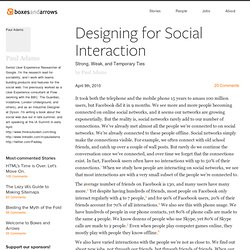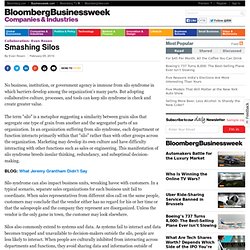

Teams. Plan. Connections. Designing for Social Interaction - Boxes and Arrows: The design. It took both the telephone and the mobile phone 15 years to amass 100 million users, but Facebook did it in 9 months.

We see more and more people becoming connected on online social networks, and it seems our networks are growing exponentially. But the reality is, social networks rarely add to our number of connections. We’ve already met almost all the people we’re connected to on social networks. We’re already connected to these people offline. Social networks simply make the connections visible. The average number of friends on Facebook is 130, and many users have many more.2 Yet despite having hundreds of friends, most people on Facebook only interact regularly with 4 to 7 people,3 and for 90% of Facebook users, 20% of their friends account for 70% of all interactions.4 We also see this with phone usage.
We also have varied interactions with the people we’re not as close to. We have many diverse relationships with the people in our lives, yet the web doesn’t support this very well. 2. 10 General Principles For Leading and Man. By As some FASTForward readers may know, I’ve worked with organizations on human resources, organizational/work design and organizational effectiveness issues for most of the past two-and-a-half decades. I’ve also been reasonably deeply involved for the past decade with the evolution of the Web and networks and how they impact knowledge work, work design, collaboration, knowledge management, and individual, group and organizational learning.
I wrote this short burst of one-pagers a few years ago in an attempt to be succinct but pithy about the range of changes we all are or will be experiencing as the interconnected environment in which we carry out work contiues to spread and penetrate the inner workings of organizations. I’ve changed a few words here and there to reflect that we’re now in 2010. I’d love to know what you think, and what I’ve missed or need to change. This fact has large implications for any organization.
Michael Schrage of MIT puts it very succinctly: You guessed it – Data ? Smashing Silos. No business, institution, or government agency is immune from silo syndrome in which barriers develop among the organization's many parts.

But adopting collaborative culture, processes, and tools can keep silo syndrome in check and create greater value. The term "silo" is a metaphor suggesting a similarity between grain silos that segregate one type of grain from another and the segregated parts of an organization. In an organization suffering from silo syndrome, each department or function interacts primarily within that "silo" rather than with other groups across the organization. Marketing may develop its own culture and have difficulty interacting with other functions such as sales or engineering. This manifestation of silo syndrome breeds insular thinking, redundancy, and suboptimal decision-making. Silo syndrome can also impact business units, wreaking havoc with customers.
Silos also commonly extend to systems and data. Collaboration Roadblocks Adopt Common Systems and Processes. Accreditation. Executive Summary What’s the Value of Accreditation? This project was undertaken to identify and understand factors that are perceived by Accredited Business Communicators (ABCs), their supervisors and their clients as adding value to the accredited individuals, the organizations they serve and the communication profession. Research was conducted in three phases in late 2007: qualitative in-depth telephone interviews were conducted with nine ABCs in the U.S. and Canada; a quantitative Web-based survey of ABCs, with 356 from seven countries participating; and Web-based surveys with 27 supervisors and 19 clients of participating ABCs.
For the survey of ABCs, the number of completions provides overall results that can be generalized to all ABCs with a margin of error of +/- 5 percentage points at a 95% confidence level. Because of low participation, the supervisor and client results are not statistically meaningful. Summary of Survey Findings Changes in approach to communication work.